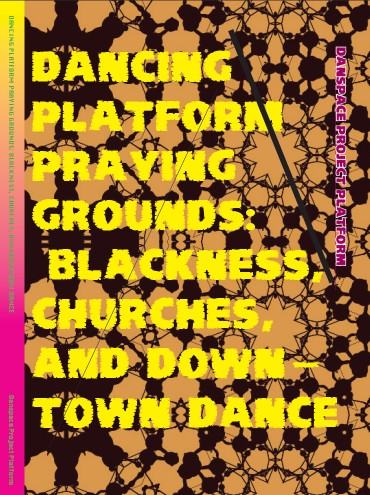Judy Hussie-Taylor: Dancing Ground (excerpt)
March 9, 2018
By Judy Hussie-Taylor
Danspace Project Executive Director and Chief Curator
Beginnings
Where are we when we stand, sit, dance, or kneel at 10th Street & 2nd Avenue in the East Village? What is this land where so many have planted, prayed, grieved, labored, organized, ranted, meditated, sung, and danced? Lenapehoking, Land of the Blacks, New Amsterdam, Bowery Village, East Village, the Lower East Side. Poet Julie Patton said, as we stood inside the sanctuary at St. Mark’s Church in-the-Bowery, “This is dancing and singing ground.”
City sites are many-layered. This Platform began with one layer, that of St. Mark’s Church Greek Revival architecture, and an old rumor that traveled from Allen Ginsberg to Steven Taylor to Judy Hussie-Taylor to Reggie Wilson, that African American worshippers sat in the balcony during the service. I asked former rector of St. Mark’s, Winnie Varghese, about this a few years ago and she said that it was historically called a “slave gallery.” This became a point of departure for the unfolding conversation with Reggie Wilson that spanned three years prior to the Platform—a conversation that would provoke a deep dive into the over 200-year-old history of the Church, and the known and unknown people and activities that shaped its transformation.
Dancing Platform Praying Grounds: Blackness, Churches, and Downtown Dance was set into motion in 2014 when Reggie’s dance company Fist and Heel Performance Group performed his piece …Moses(es) at St. Cornelius Chapel on Governor’s Island as part of the River to River Festival. We began a series of conversations that led me to invite Reggie to curate the 12th Danspace Project Platform; Reggie, Program Director Lydia Bell and I began our research in 2015 and were later joined by Platform scholar-in-residence, historian Prithi Kanakamedala, and Curatorial Assistant and Managing Editor Kristin Juarez, all of whom have made significant contributions to the Platform.
Reggie’s initial lines of inquiry provided the pathway for us and for the artists:
- What is the relationship between postmodern dance, religious architecture, and race in New York City and at other US sites?
- What are the implications of religiously affiliated spaces as homes for dance in New York: Judson Memorial Church, St. Mark’s Church in-the-Bowery, 92nd Street Y, and Dia [1] Center for the Arts on Mercer Street?
- How did Civil Rights grass roots activism and organization in churches and community centers make way for new models for performance, dance, arts organizing, and presentation?
These questions were informed by Reggie’s decades-long research into African Diaspora dance, and religions, and his belief in the body as a vessel of knowledge. As Reggie notes in his conversation with Thomas F. DeFrantz, the Diaspora is not limiting or limited, and New York City—Downtown in particular—plays a significant role in the history of dance and its future.
The Platform events will take many forms. Reggie invited a racially and aesthetically diverse range of artists to create short new works in shared evening formats. They are: Keely Garfield, Beth Gill, Jonathan Gonzalez, Miguel Gutierrez, Angie Pittman, Same as Sister (Briana Brown-Tipley, and Hilary Brown), Edisa Weeks, and Ni’Ja Whitson. Fist and Heel will premiere…they stood shaking while others began to shout. Scholars Brenda Dixon Gottschild, Cynthia Copeland, Kanakamedala, and artist Emily Johnson were invited to create unique walking tours each week of the Platform. A five-hour symposium and love feast [2] on March 10 will weave scholarly presentations, performances, rituals, and feasting together over five hours (see full Platform program calendar on the last page of this catalogue).
The catalogue is divided into three sections: Architecture, History, and Dance. Neither the Platform events or the catalogue are intended to set the record straight. What’s proposed here, informed by Reggie’s process, is how multiple histories and lenses can activate poetic, artistic, and choreographic propositions. How does history inspire generative speculation and empathic imagination? How might we conjure those who’ve moved on this ground before us?
Dance critic Deborah Jowitt once wrote that the St. Mark’s sanctuary is a palimpsest. A palimpsest, according to Merriam Webster, is a parchment or tablet used one or more times after earlier writing has been erased. It has come to refer to something having diverse layers but with aspects apparent beneath the surface. Dancing Platform Praying Ground builds on the barely perceivable layers beneath the surface and will add yet another layer relevant to our time.
Welcome to dancing and singing ground. This is where we are.
—
[1] Dia is the Greek word for “through.”
[2] Merriam-Webster Definition of love feast:
1: a meal eaten in common by a Christian congregation in token of brotherly love
2: a gathering held to promote reconciliation and good feeling or show someone affectionate honor
(Adapted from the Introduction of Dancing Platform Praying Grounds: Blackness, Churches, and Downtown Dance)
